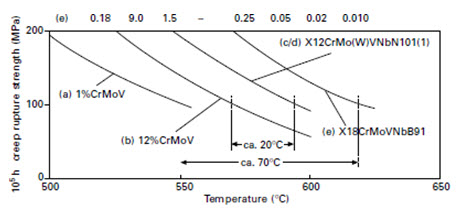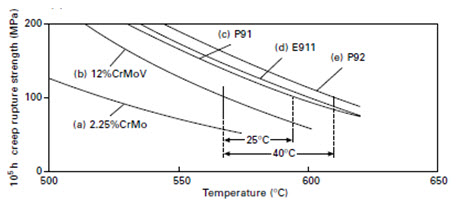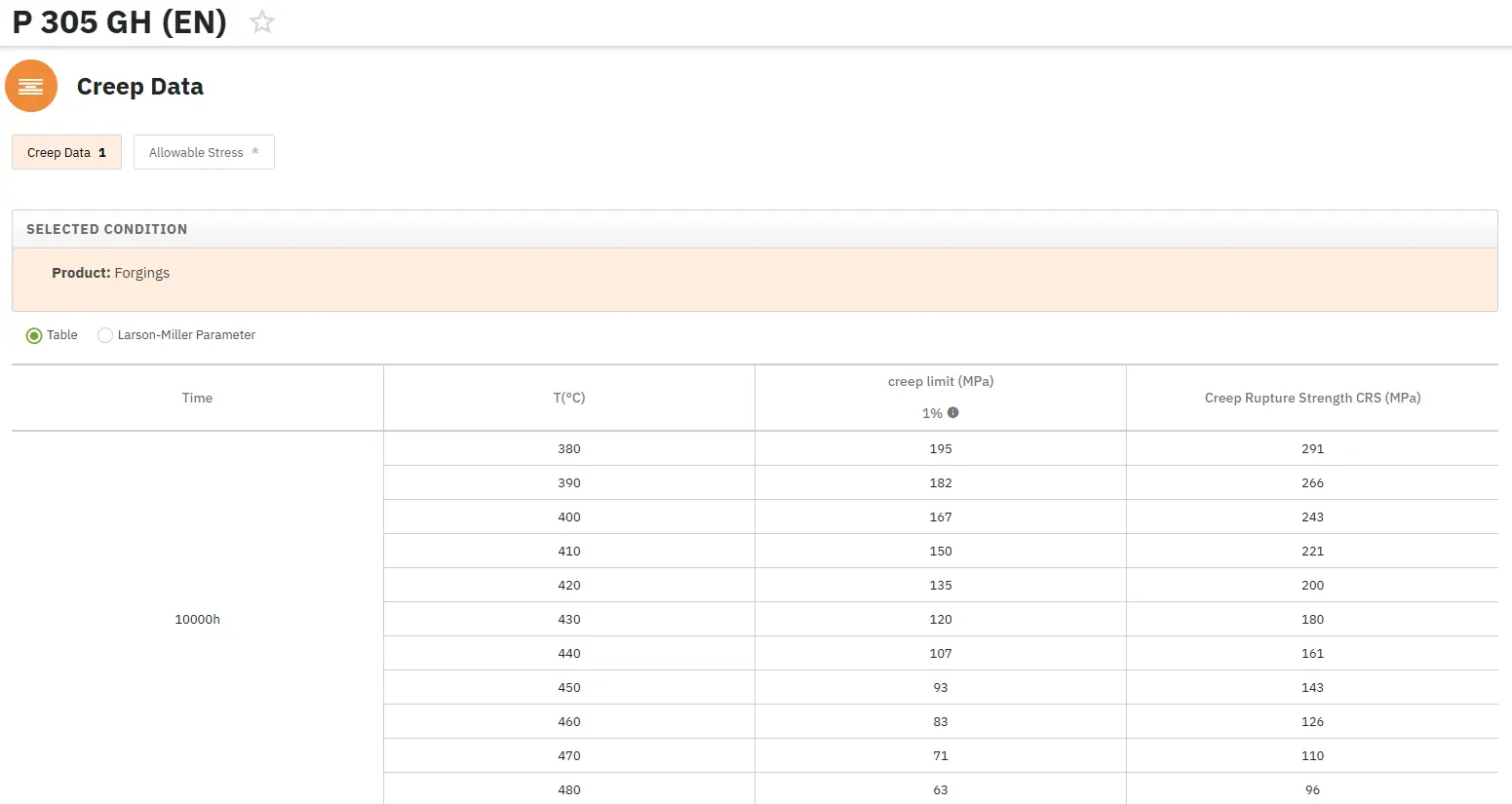9–12% Chromium Steels: Part Two
Abstract
An overview of the development of heat-resistant ferritic-martensitic 9-12% Cr steels from the 1980s is given in this article. The properties of several 9–12% chromium steels are described, with examples of the graphs of 100,000 h creep rupture strength of steam turbine rotor steels and piping steels.
The steel referred to in the literature as 9Cr1Mo or P91 (no. 6) is a steel of the newer generation. It was developed under a huge American national project in the late 1970s for manufacturing pipes and vessels for a fast breeder reactor. It is tough, readily weldable and, as shown by creep tests at 593°C up to about 80,000 h, has a high creep strength at 600°C and 100,000 h of about 94 MPa.
In comparison with earlier steels it is characterized, for example, by a lower C content of only about 0.10% and a reduced Cr content of about 9%. This steel has meanwhile found wide application in all new Japanese and European power stations for the manufacture of pipes and small forgings. It is also used for the manufacture of valve chests and turbine casings.
Steel HCM 12 (no. 7) is a newly developed Japanese 12% Cr steel with 0.10% C – 1% Mo – 1% W – 0.25% V – 0.05% Nb – 0.03% N and a duplex structure of delta-ferrite and tempered martensite with improved weldability and creep strength. The stability of the creep strength of this steel has been obtained primarily by precipitation strengthening with very fine VN precipitates and high-temperature tempering at over 800°C.
Experience with this steel has already been accumulated over a period of more than 20 years. The steel has been extensively used for superheater tubes in chemical recovery boilers exposed to severe high-temperature corrosion attack. The good resistance to corrosion is due to the high Cr-content of 12%.
The Japanese rotor steels TMK 1 and TMK 2 (no. 8), developed in the 1980s, were based on the known properties of steels no. 1–6. Compared with the GE rotor steel (no. 5), the C content in particular was reduced and the sum total (C + N) was selected at around 0.17%. Based on the research work of Fujita, the Mo content was raised to 1.5% in TMK 1, whereas TMK 2 is additionally alloyed with about 1.8%W. The Mo content is simultaneously balanced to 0.50% in keeping with Fujita’s result that the highest solution hardening was obtained with (Mo + 0.5W) = 1.5%. Both rotor steels have been used for new power stations in Japan.
Rotor steels nos. 9 and 10 are primarily the result of research work performed in the 1980s under the European cooperation program COST 501. Steel no. 9 is a 9%CrMoVNb steel which is additionally alloyed with about 0.01% boron. It is an onward development of the TAF steel for large components with reduced contents of Cr, Nb and B and with an increase in V.
Creep tests with specimens from a 900 mm diameter pilot rotor, which have so far reached about 100,000 h, indicate a probable creep rupture strength of about 120 MPa at 100,000 h and 600°C. Creep tests up to 94,000 h with specimens from a 600 mm diameter pilot rotor with a similar composition confirm this value. A larger pilot rotor with a diameter of about 1200 mm is under investigation.
The creep strength of the steel X12CrMoWVNbN10-1-1 (steel no. 10) containing 0.06%N instead of 0.01%B and only 1% Mo instead of 1.5% Mo and, in addition, 0.8% W, is about 20% lower, see Figure 3. So far, the longest test period is about 100,000 h.
This rotor steel has primarily been used for the new advanced European steam power plants. This steel type has also successfully been applied for many valve chests and turbine casings in the new plants.
The pipe steel, E 911, developed under COST 501, features a somewhat comparable chemical composition. The Cr content was reduced to roughly 9%. The Ni content is also distinctly lower since because of the lower Cr content there is no risk of the occurrence of delta-ferrite. Based on results up to roughly 100,000 h, the creep rupture strength of this steel is estimated to be 98 MPa at 600°C and 100,000 h.

Figure 3: 100,000 h creep rupture strength of steam turbine rotor steels as a function of test temperature.
Steel no. 11 is also based on the research work of Fujita. It is a 9% Cr pipe steel specifically alloyed with 0.10% C – 1.8% W – 0.5% Mo – 0.2% V – 0.06% Nb – 0.05% N and about 0.003%B and tempered at about 750°C. It was developed in the second half of the 1980s under the designation NF 616 (P92). Based on creep tests up to about 100,000 h, the creep rupture strength is estimated to be 113 MPa at 600°C and 100,000 h.
A similar pipe steel HCM 12A (P122), steel no. 12, has also been developed in Japan alloyed with a higher Cr content of 11% in order to improve oxidation resistance. About 1% copper has been added to reduce the tendency to delta ferrite formation caused by the higher Cr-content.
The newest evaluation of the available results of long term creep tests led to an estimated creep rupture strength of 101MPa at 600°C and 100,000 h. Figure 4 compares the 100,000 h creep rupture strength versus the temperature for the new pipe steels. In addition to the pipe steel P91, all three pipe steels (E 911, NF 616 and HCM 12A) are in successful use for the new advanced steam power plants.

Figure 4: 100,000h creep rupture strength of steam plant piping steels as a function of test temperature.
Read more
Access Creep Properties of Thousands of Materials Now!
Total Materia Horizon includes the largest database of creep data such as yield stress and creep rupture strength at different temperatures, for thousands of metallic alloys and polymers.

Get a FREE test account at Total Materia Horizon and join a community of over 500,000 users from more than 120 countries.